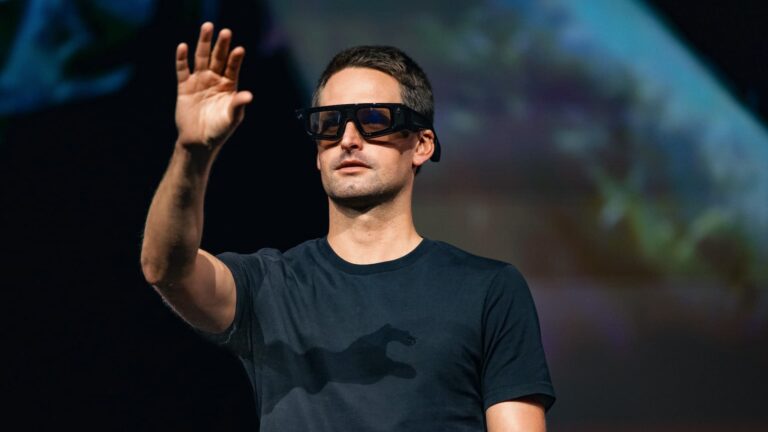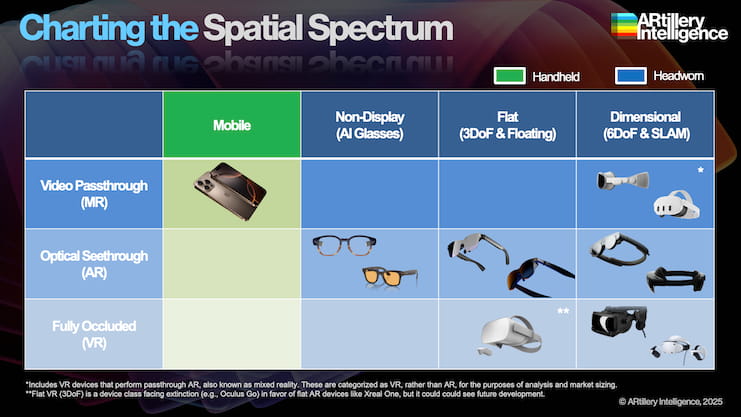
Last August, ARtillery Intelligence’s monthly report focused on smart glasses. Given new standards set by Ray-Ban Meta Smartglasses, Xreal, Viture, and others, smart glasses are seeing demand inflections. Much of this success is built on the principle of “lite AR.”
What is lite AR? After a decade of chasing “heavy AR” ambitions, many XR players got realistic about the technology’s shortcomings. They’re zeroing in on the technology’s best self today, rather than aiming for overly ambitious ends. This means simpler visuals… or no visuals at all.
Following that narrative, we now embark upon the next chapter: heavy AR. Also known as dimensional AR, this is defined by visuals that understand and interact with their surroundings in dimensionally-accurate ways. It’s all about simultaneous localization and mapping (SLAM).
These scene-interaction and dimensionality functions are computationally intensive. That in turn forces design tradeoffs. For example, SLAM requires high-end graphical processing and presents challenges like heat dissipation, device bulk, and cost (Karl Kuttag explains it best).
Though these challenges persist, we’re seeing notable evolution, such as hardware in the past year from Snap (Spectacles Gen 5) and Meta (Orion). But there’s still a long way to go. This is the topic of a recent ARtillery Intelligence report, which joins our weekly excerpt series.
AR Continuum
As AR evolves, it continues to branch into several form factors. For example, two overarching directions are video passthrough (VPT) and optical seethrough (OST). The latter is subdivided by non-interactive (flat AR) and interactive/dimensional visuals (dimensional AR).
Among these combinations of factors, this report focuses on the last one: OST that offers interactive and dimensional visuals. But before diving into that specific segment of the AR continuum, let’s step back and examine all the above formats for perspective and context.
Starting with VPT, it utilizes exterior HD color cameras that project the outside world into the device. Also known as mixed reality, graphics are then integrated in ways that interact with physical spaces. Examples include Quest 3 and Apple Vision Pro (and technically, mobile AR).
OST meanwhile involves transparent lenses on which graphics are projected. This often includes waveguide-based projection systems that guide light to its destination; and liquid crystal on silicon (LCOS) or MicroLED displays. Examples include Snap Spectacles and Meta Orion.
Things get much more complicated and nuanced with the pros and cons of the above approaches, as well as other variables like illumination (again, see Karl Guttag’s breakdown). There are also wild cards that deviate from traditional approaches, such as laser beam scanning.

Parallel Paths
Sticking with the VPT/OST bisection for now, VPT offers a larger field of view, control over every pixel, and color contrast. But devices are bulky. OST conversely offers a lighter form factor and awareness of one’s surroundings. That translates to greater mobility and social acceptability.
That last part tends to favor OST as the long-run winner among XR proponents. The thought is that it’s not commercially viable to expect consumers to wear something like Quest 3 while socializing, driving, or generally being seen in public. AR’s ideal form factor is an all-day wearable.
For all these reasons, the industry consensus tends to paint VPT as a good option today, given its optical advantages noted above… but it’s a stepping stone. In that same train of thought, it’s projected (but debatable) that OST will work out its kinks and gain the VPT-like UX advantages.
This linear construct has merit, but we see parallel evolutionary paths, where design choice is use-case driven. For example, VPT will always be better for lean-back entertainment, while OST will always be better for situational awareness, social acceptability, and all-day use.
Though it’s tempting to imagine one device that does everything, it’s more likely – at least in the next decade – that purpose-built approaches will coexist. It’s the same reason you use both a smartphone and a laptop, rather than the compromised endpoint of doing everything on a tablet.
We’ll pause there and pick things up in the next installment of this excerpt series to go deeper on OST AR dynamics…
